Updating your garage door is one of the most affordable home renovation projects. A new garage door can enhance your home’s curb appeal and improve daily convenience.
When purchasing a garage door, the first thing to consider is its size. What are the most common garage door sizes? How do you accurately determine the right size for your needs? This guide will answer all your questions about garage door sizes.
Common Residential Garage Door sizes
There is no single “standard” garage door measurement. Instead, garage door sizes are generally grouped based on the number of vehicles they are designed to accommodate.
Single Car Garages:
Single-car garages typically feature one door, with common widths of 8, 9, or 10 feet. The standard height ranges from 7 to 8 feet, which is sufficient for most cars and SUVs
Double Car Garages:
Double-car garage doors are commonly 16, 18, or 20 feet wide, with 16 feet being the most popular for accommodating two vehicles. Heights are usually 7 or 8 feet, with 8 feet providing extra clearance compared to the standard 7 feet for single doors.
Three Car Garages:
Three-car garages are increasingly common in larger homes. Typical configurations include one double door and one single door, or three separate single doors.

Choosing the Right Size: It’s More Than Just the Opening!
Selecting the correct garage door size involves more than just matching the opening. Several important factors should be considered.
- Your Vehicle(s): Consider both your current vehicles and any you may own in the future. While a standard 8’x7′ door fits many cars, larger SUVs, trucks, or vehicles with roof racks may require a 9- or 10-foot wide door, and possibly an 8-foot or taller door for adequate clearance.
- How You Use Your Garage: If you use your garage for storage, a workshop, or hobbies in addition to parking, extra width or height can provide essential space for moving around, storing equipment, or setting up a workbench.
- Specialty Vehicles: If you have a golf cart, boat, garden tractor, or RV, you may need a custom or oversized garage door. RV doors, for example, are often 12–16 feet high and 12–14 feet wide.
- Garage Structure: The architecture of your garage, including the header and surrounding walls, determines whether a wider or taller door can be installed without major modifications. Limited headroom may require special tracks or roof adjustments.
- Appearance: The style and material of your garage door significantly affect your home’s curb appeal. For example, a modern aluminum double-car garage door can transform the exterior look of your house.
- Budget: Larger or custom-sized garage doors generally cost more, so it is important to balance your needs with your budget.

Custom and Oversized Garage Doors
In some cases, standard garage door sizes may not be suitable.
- Custom garage doors are necessary if your garage opening has unique dimensions or if you have specific vehicle requirements, such as exceptionally large equipment or small vehicles like motorcycles and four-wheelers.
- Many manufacturers offer custom-sized garage doors, and some may provide these at no additional cost compared to standard sizes.
- For small garages or specialized uses, such as storing a mower or motorcycle, doors as narrow as 4 to 6 feet wide are available.
- For larger vehicles, such as SUVs and trucks, doors measuring 10’x8′ are increasingly popular, though not standard in new construction. Dedicated RV garage doors are typically 12–14 feet wide and 12–16 feet high.

How to Measure Garage Door Sizes
Accurately measuring your garage door opening is essential for a proper fit.
- Precise measurements ensure a proper fit, smooth operation, and adequate security and insulation for your new garage door. An incorrectly sized door can result in gaps, reduced security, and operational issues.
- Always measure the rough opening—the framed space where the garage door will be installed—rather than just the old door itself. The new door’s size should be based on these dimensions. When measuring, use the smallest value for each dimension to ensure a proper fit.
Other Factors to Consider When Buying a Garage Door
In addition to size, consider the following factors when selecting a garage door:
- Door Type: Sectional doors are the most common and come in a wide range of sizes. Other types, such as roller shutters, side-hinged, and up-and-over doors, have different size and clearance requirements.
- Material and Insulation: The material and insulation level affect available sizes, cost, and performance. Insulated garage doors, while more expensive, offer increased durability and energy efficiency.
Cost: Size is a major factor in overall cost, along with material, insulation, and the number of openers needed.
Maintenance: Proper installation of the correct size door simplifies maintenance. Regular checks and lubrication are important for smooth operation.
Safety & Security: A properly sized door that fits tightly improves security and ensures safer, more reliable operation.

Conclusion
Selecting the appropriate garage door size involves careful consideration of your garage’s dimensions, current and future vehicle needs, and how you use the space. Accurate measurement of width, height, side room, headroom, and backroom is essential.
If you need assistance determining the right size or style, consult with professionals for expert guidance.


